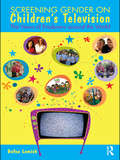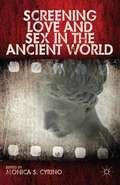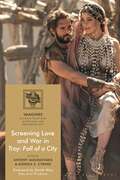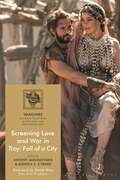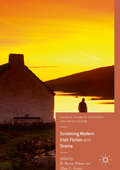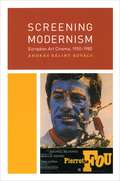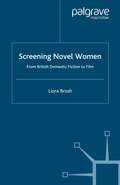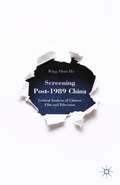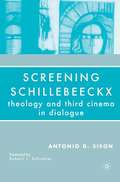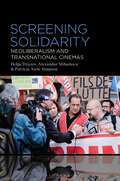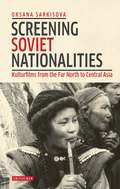- Table View
- List View
Screening Gender on Children's Television: The Views of Producers around the World
by Dafna LemishScreening Gender on Children’s Television offers readers insights into the transformations taking place in the presentation of gender portrayals in television productions aimed at younger audiences. It goes far beyond a critical analysis of the existing portrayals of gender and culture by sharing media professionals’ action-oriented recommendations for change that would promote gender equity, social diversity and the wellbeing of children. Incorporating the author’s interviews with 135 producers of children’s television from 65 countries, this book discusses the role television plays in the lives of young people and, more specifically, in developing gender identity. It examines how gender images presented to children on television are intertwined with important existential and cultural concerns that occupy the social agenda worldwide, including the promotion of education for girls, prevention of HIV/AIDS and domestic violence and caring for ‘neglected’ boys who lack healthy masculine role models, as well as confronting the pressures of the beauty myth. Screening Gender on Children’s Television also explores how children’s television producers struggle to portray issues such as sex/sexuality and the preservation of local cultures in a profit-driven market which continually strives to reinforce gender segregation. The author documents pro-active attempts by producers to advance social change, illustrating how television can serve to provide positive, empowering images for children around the world. Screening Gender on Children’s Television is an accessible text which will appeal to a wide audience of media practitioners as well as students and scholars. It will be useful on a range of courses, including popular culture, gender, television and media studies. Researchers will also be interested in the breadth of this cross-cultural study and its interviewing methodology.
Screening Gender on Children's Television: The Views of Producers around the World
by Dafna LemishScreening Gender on Children’s Television offers readers insights into the transformations taking place in the presentation of gender portrayals in television productions aimed at younger audiences. It goes far beyond a critical analysis of the existing portrayals of gender and culture by sharing media professionals’ action-oriented recommendations for change that would promote gender equity, social diversity and the wellbeing of children. Incorporating the author’s interviews with 135 producers of children’s television from 65 countries, this book discusses the role television plays in the lives of young people and, more specifically, in developing gender identity. It examines how gender images presented to children on television are intertwined with important existential and cultural concerns that occupy the social agenda worldwide, including the promotion of education for girls, prevention of HIV/AIDS and domestic violence and caring for ‘neglected’ boys who lack healthy masculine role models, as well as confronting the pressures of the beauty myth. Screening Gender on Children’s Television also explores how children’s television producers struggle to portray issues such as sex/sexuality and the preservation of local cultures in a profit-driven market which continually strives to reinforce gender segregation. The author documents pro-active attempts by producers to advance social change, illustrating how television can serve to provide positive, empowering images for children around the world. Screening Gender on Children’s Television is an accessible text which will appeal to a wide audience of media practitioners as well as students and scholars. It will be useful on a range of courses, including popular culture, gender, television and media studies. Researchers will also be interested in the breadth of this cross-cultural study and its interviewing methodology.
Screening Love and Sex in the Ancient World
by Monica S. CyrinoThis dynamic collection of essays by international film scholars and classicists addresses the provocative representation of sexuality in the ancient world on screen. A critical reader on approaches used to examine sexuality in classical settings, contributors use case studies from films and television series spanning from the 1920s to the present.
Screening Love and War in Troy: Fall of a City (IMAGINES – Classical Receptions in the Visual and Performing Arts)
by Antony Augoustakis and Monica S. CyrinoThis is the first volume of essays published on the television series Troy: Fall of a City (BBC One and Netflix, 2018). Covering a wide range of engaging topics, such as gender, race and politics, international scholars in the fields of classics, history and film studies discuss how the story of Troy has been recreated on screen to suit the expectations of modern audiences. The series is commended for the thought-provoking way it handles important issues arising from the Trojan War narrative that continue to impact our society today. With discussions centered on epic narrative, cast and character, as well as tragic resonances, the contributors tackle gender roles by exploring the innovative ways in which mythological female figures such as Helen, Aphrodite and the Amazons are depicted in the series. An examination is also made into the concept of the hero and how the series challenges conventional representations of masculinity. We encounter a significant investigation of race focusing on the controversial casting of Achilles, Patroclus, Zeus and other series characters with Black actors. Several essays deal with the moral and ethical complexities surrounding warfare, power and politics. The significance of costume and production design are also explored throughout the volume.
Screening Love and War in Troy: Fall of a City (IMAGINES – Classical Receptions in the Visual and Performing Arts)
This is the first volume of essays published on the television series Troy: Fall of a City (BBC One and Netflix, 2018). Covering a wide range of engaging topics, such as gender, race and politics, international scholars in the fields of classics, history and film studies discuss how the story of Troy has been recreated on screen to suit the expectations of modern audiences. The series is commended for the thought-provoking way it handles important issues arising from the Trojan War narrative that continue to impact our society today. With discussions centered on epic narrative, cast and character, as well as tragic resonances, the contributors tackle gender roles by exploring the innovative ways in which mythological female figures such as Helen, Aphrodite and the Amazons are depicted in the series. An examination is also made into the concept of the hero and how the series challenges conventional representations of masculinity. We encounter a significant investigation of race focusing on the controversial casting of Achilles, Patroclus, Zeus and other series characters with Black actors. Several essays deal with the moral and ethical complexities surrounding warfare, power and politics. The significance of costume and production design are also explored throughout the volume.
Screening Modern Irish Fiction and Drama (Palgrave Studies in Adaptation and Visual Culture)
by R. Barton Palmer Marc C. ConnerThis book offers the first comprehensive discussion of the relationship between Modern Irish Literature and the Irish cinema, with twelve chapters written by experts in the field that deal with principal films, authors, and directors. This survey outlines the influence of screen adaptation of important texts from the national literature on the construction of an Irish cinema, many of whose films because of cultural constraints were produced and exhibited outside the country until very recently. Authors discussed include George Bernard Shaw, Oscar Wilde, Liam O’Flaherty, Christy Brown, Edna O’Brien, James Joyce, and Brian Friel. The films analysed in this volume include THE QUIET MAN, THE INFORMER, MAJOR BARBARA, THE GIRL WITH GREEN EYES, MY LEFT FOOT, THE PICTURE OF DORIAN GRAY, THE SNAPPER, and DANCING AT LUGHNASA. The introduction features a detailed discussion of the cultural and political questions raised by the promotion of forms of national identity by Ireland’s literary and cinematic establishments.
Screening Modernism: European Art Cinema, 1950-1980 (Cinema and Modernity)
by András Bálint KovácsCasting fresh light on the renowned productions of auteurs like Antonioni, Fellini, and Bresson and drawing out from the shadows a range of important but lesser-known works, Screening Modernism is the first comprehensive study of European art cinema’s postwar heyday. Spanning from the 1950s to the 1970s, András Bálint Kovács’s encyclopedic work argues that cinematic modernism was not a unified movement with a handful of styles and themes but rather a stunning range of variations on the core principles of modern art. Illustrating how the concepts of modernism and the avant-garde variously manifest themselves in film, Kovács begins by tracing the emergence of art cinema as a historical category. He then explains the main formal characteristics of modern styles and forms as well as their intellectual foundation. Finally, drawing on modernist theory and philosophy along the way, he provides an innovative history of the evolution of modern European art cinema. Exploring not only modernism’s origins but also its stylistic, thematic, and cultural avatars, Screening Modernism ultimately lays out creative new ways to think about the historical periods that comprise this golden age of film.
Screening Modernism: European Art Cinema, 1950-1980 (Cinema and Modernity)
by András Bálint KovácsCasting fresh light on the renowned productions of auteurs like Antonioni, Fellini, and Bresson and drawing out from the shadows a range of important but lesser-known works, Screening Modernism is the first comprehensive study of European art cinema’s postwar heyday. Spanning from the 1950s to the 1970s, András Bálint Kovács’s encyclopedic work argues that cinematic modernism was not a unified movement with a handful of styles and themes but rather a stunning range of variations on the core principles of modern art. Illustrating how the concepts of modernism and the avant-garde variously manifest themselves in film, Kovács begins by tracing the emergence of art cinema as a historical category. He then explains the main formal characteristics of modern styles and forms as well as their intellectual foundation. Finally, drawing on modernist theory and philosophy along the way, he provides an innovative history of the evolution of modern European art cinema. Exploring not only modernism’s origins but also its stylistic, thematic, and cultural avatars, Screening Modernism ultimately lays out creative new ways to think about the historical periods that comprise this golden age of film.
Screening Modernism: European Art Cinema, 1950-1980 (Cinema and Modernity)
by András Bálint KovácsCasting fresh light on the renowned productions of auteurs like Antonioni, Fellini, and Bresson and drawing out from the shadows a range of important but lesser-known works, Screening Modernism is the first comprehensive study of European art cinema’s postwar heyday. Spanning from the 1950s to the 1970s, András Bálint Kovács’s encyclopedic work argues that cinematic modernism was not a unified movement with a handful of styles and themes but rather a stunning range of variations on the core principles of modern art. Illustrating how the concepts of modernism and the avant-garde variously manifest themselves in film, Kovács begins by tracing the emergence of art cinema as a historical category. He then explains the main formal characteristics of modern styles and forms as well as their intellectual foundation. Finally, drawing on modernist theory and philosophy along the way, he provides an innovative history of the evolution of modern European art cinema. Exploring not only modernism’s origins but also its stylistic, thematic, and cultural avatars, Screening Modernism ultimately lays out creative new ways to think about the historical periods that comprise this golden age of film.
Screening Nature: Cinema beyond the Human
by Anat Pick Guinevere NarrawayEnvironmentalism and ecology are areas of rapid growth in academia and society at large. Screening Nature is the first comprehensive work that groups together the wide range of concerns in the field of cinema and the environment, and what could be termed “posthuman cinema.” It comprises key readings that highlight the centrality of nature and nonhuman animals to the cinematic medium, and to the language and institution of film. The book offers a fresh and timely intervention into contemporary film theory through a focus on the nonhuman environment as principal register in many filmic texts. Screening Nature offers an extensive resource for teachers, undergraduate students, and more advanced scholars on the intersections between the natural world and the worlds of film. It emphasizes the cross-cultural and geographically diverse relevance of the topic of cinema ecology.
Screening Nature: Cinema beyond the Human
by Anat Pick Guinevere NarrawayEnvironmentalism and ecology are areas of rapid growth in academia and society at large. Screening Nature is the first comprehensive work that groups together the wide range of concerns in the field of cinema and the environment, and what could be termed “posthuman cinema.” It comprises key readings that highlight the centrality of nature and nonhuman animals to the cinematic medium, and to the language and institution of film. The book offers a fresh and timely intervention into contemporary film theory through a focus on the nonhuman environment as principal register in many filmic texts. Screening Nature offers an extensive resource for teachers, undergraduate students, and more advanced scholars on the intersections between the natural world and the worlds of film. It emphasizes the cross-cultural and geographically diverse relevance of the topic of cinema ecology.
Screening The Novel: The Theory And Practice Of Literary Dramatization
by Keith Selby Robert Giddings Chris WensleyThe book takes as its theme the relationship between literature and the contemporary means of production and distribution collectively termed 'the media' - in particular, film and television. The intention of the book is to explore and evaluate the mutual opportunities and restrictions in this relationship. In the grammar of our culture there seems to be an accepted opinion that print is superior in terms of cultural production to film, radio or television, that to read a book is somehow a 'higher' cultural activity than seeing a play on television or seeing a film. By the same token, a novel is a 'superior' work of art to film or television. The longer perspective reveals that traditionally there always is a greater respect paid to the previous mode of literary production - poetry was superior to drama, poetic drama was superior to the novel, and film attained cult and classic status initially over television.
Screening Novel Women: From British Domestic Fiction to Film
by Liora BroshFrom Hollywood classics like Jane Eyre or Wuthering Heights to the 1990s wave of Jane Austen films, adaptations of the British Nineteenth-century novel have been sensationally popular. This book examines how British and American filmmakers used the domestic novels of the past to construct stable gender ideals for the present.
The Screening of America: Movies and Values from Rocky to Rain Man (Film Studies: Bloomsbury Academic Collections)
by Tom O'BrienThis is an original investigation of how movies have reflected and helped to shape the values of a generation. From All the President's Men to Wall Street, US films of the 1970s and 80s were a kaleidoscope of shifting values and contrasting moral viewpoints. Knowing that movies mirror the way we think we are – or would like to be – O'Brien focuses on the key values (or their absence) found in films from this period in order to see more clearly what Americans really cherished in life, and how these values have evolved or changed. Comprehensive and thought provoking, this book addresses how and why movies glamorized and portrayed certain professions; the changing role of women; the targeting of religion for satire; the addressing of environmental issues and film's representation of and engagement with history.
Screening Post-1989 China: Critical Analysis of Chinese Film and Television
by W. HoThis unique book investigates the tug-of-war between the free market economy and authoritative state regulation in Chinese culture after 1989. Contextualizing close textual readings of cinematic and television texts, both officially sanctioned and independently made, Wing Shan Ho illuminates the complex process in which cultural producers and consumers negotiate with both the state and the market in articulating new forms of subjectivity. Ho examines the types of Chinese subjects that the state applauds and aggrandizes in contrast to those that it condemns and attempts to eliminate. Her focus on the socialist spirit exposes inherent contradictions in the current Chinese project of nation-building. This comparative study shines a harsh light on these cultural products and on much more: the confluence between commerce and politics and popular culture, the interaction between state and individuals in popular culture, and the complexity of governmentality in an era of globalization.
Screening Queer Memory: LGBTQ Pasts in Contemporary Film and Television (Library of Gender and Popular Culture)
by Anamarija HorvatIn Screening Queer Memory, Anamarija Horvat examines how LGBTQ history has been represented on-screen, and interrogates the specificity of queer memory. She poses several questions: How are the pasts of LGBTQ people and communities visualised and commemorated on screen? How do these representations comment on the influence of film and television on the construction of queer memory? How do they present the passage of memory from one generation of LGBTQ people to another? Finally, which narratives of the queer past, particularly of the activist past, are being commemorated, and which obscured?Horvat exemplifies how contemporary British and American cinema and television have commented on the specificity of queer memory - how they have reflected aspects of its construction, as well as participated in its creation. In doing so, she adds to an under-examined area of queer film and television research which has privileged concepts of nostalgia, history, temporality and the archive over memory. Films and television shows explored include Cheryl Dunye's The Watermelon Woman (1996), Todd Haynes' Velvet Goldmine (1998), Jill Soloway's Transparent (2014-2019), Matthew Warchus' Pride (2014) and Tom Rob Smith's London Spy (2015).
Screening Queer Memory: LGBTQ Pasts in Contemporary Film and Television (Library of Gender and Popular Culture)
by Anamarija HorvatIn Screening Queer Memory, Anamarija Horvat examines how LGBTQ history has been represented on-screen, and interrogates the specificity of queer memory. She poses several questions: How are the pasts of LGBTQ people and communities visualised and commemorated on screen? How do these representations comment on the influence of film and television on the construction of queer memory? How do they present the passage of memory from one generation of LGBTQ people to another? Finally, which narratives of the queer past, particularly of the activist past, are being commemorated, and which obscured?Horvat exemplifies how contemporary British and American cinema and television have commented on the specificity of queer memory - how they have reflected aspects of its construction, as well as participated in its creation. In doing so, she adds to an under-examined area of queer film and television research which has privileged concepts of nostalgia, history, temporality and the archive over memory. Films and television shows explored include Cheryl Dunye's The Watermelon Woman (1996), Todd Haynes' Velvet Goldmine (1998), Jill Soloway's Transparent (2014-2019), Matthew Warchus' Pride (2014) and Tom Rob Smith's London Spy (2015).
Screening Reality: How Documentary Filmmakers Reimagined America
by Jon Wilkman"Authoritative, accessible, and elegantly written, Screening Reality is the history of American documentary film we have been waiting for." --Kenneth Turan, Los Angeles Times film criticFrom Edison to IMAX, Ken Burns to virtual environments, the first comprehensive history of American documentary film and the remarkable men and women who changed the way we view the world.Amidst claims of a new “post-truth” era, documentary filmmaking has experienced a golden age. Today, more documentaries are made and widely viewed than ever before, illuminating our increasingly fraught relationship with what's true in politics and culture. For most of our history, Americans have depended on motion pictures to bring the realities of the world into view. And yet the richly complex, ever-evolving relationship between nonfiction movies and American history is virtually unexplored. Screening Reality is a widescreen view of how American “truth” has been discovered, defined, projected, televised, and streamed during more than one hundred years of dramatic change, through World Wars I and II, the dawn of mass media, the social and political turmoil of the sixties and seventies, and the communications revolution that led to a twenty-first century of empowered yet divided Americans. In the telling, professional filmmaker Jon Wilkman draws on his own experience, as well as the stories of inventors, adventurers, journalists, entrepreneurs, artists, and activists who framed and filtered the world to inform, persuade, awe, and entertain. Interweaving American and motion picture history, and an inquiry into the nature of truth on screen, Screening Reality is essential and fascinating reading for anyone looking to expand an understanding of the American experience and today's truth-challenged times.
Screening Scarlett Johansson: Gender, Genre, Stardom
by Janice Loreck Whitney Monaghan Kirsten StevensScreening Scarlett Johansson: Gender, Genre, Stardom provides an account of Johansson’s persona, work and stardom, extending from her breakout roles in independent cinema, to contemporary blockbusters, to her self-parodying work in science-fiction. Screening Scarlett Johansson is more than an account of Johansson’s career; it positions Johansson as a point of reference for interrogating how femininity, sexuality, identity and genre play out through a contemporary woman star and the textual manipulations of her image. The chapters in this collection cast a critical eye over the characters Johansson has portrayed, the personas she has inhabited, and how the two intersect and influence one another. They draw out the multitude of meanings generated through and inherent to her performances, specifically looking at processes of transformation, metamorphosis and self-deconstruction depicted in her work.
Screening Schillebeeckx: Theology and Third Cinema in Dialogue
by A. SisonThe book is an exploration of the creative crossings between the liberative stream of the eschatology of Edward Schillebeeckx and the stylistic strategies of 'Third Cinema', political cinema dedicated to the representation of Third World liberation.
Screening Solidarity: Neoliberalism and Transnational Cinemas
by Helga Druxes Alexandar Mihailovic Patricia Anne SimpsonWestern neoliberalism is a predatory outgrowth of late capitalism that overvalues competition, transferring the laws of the market to human relationships. This book advances the argument that anti-neoliberal cinemas of Europe, the United States, and the Russian Federation imagine and visualize alternatives to the non-sovereign realities of a neoliberal workplace that unequivocally endorses dangerous risk-taking, self-optimizing neoliberal subjects, and corporate 'entrepreneurs of self.' Always at stake in the examination of neoliberalism's consequences is a human being who is indexed by race, gender, nation, ability, and economic performance. Drawing on film theory, transnational social histories, critical race theory, and Marxist and Foucauldian interpretive models, this book rediscovers a cinema that imagines a social contract focused on the common good and ethical standards for the social state. Anti-neoliberal cinema empowers the viewer as agentive through narratives that detail resistance to Western neoliberal modes of living and working. These filmmakers dramatize the labor of making solidarity across different groups.
Screening Solidarity: Neoliberalism and Transnational Cinemas
by Helga Druxes Alexandar Mihailovic Patricia Anne SimpsonWestern neoliberalism is a predatory outgrowth of late capitalism that overvalues competition, transferring the laws of the market to human relationships. This book advances the argument that anti-neoliberal cinemas of Europe, the United States, and the Russian Federation imagine and visualize alternatives to the non-sovereign realities of a neoliberal workplace that unequivocally endorses dangerous risk-taking, self-optimizing neoliberal subjects, and corporate 'entrepreneurs of self.' Always at stake in the examination of neoliberalism's consequences is a human being who is indexed by race, gender, nation, ability, and economic performance. Drawing on film theory, transnational social histories, critical race theory, and Marxist and Foucauldian interpretive models, this book rediscovers a cinema that imagines a social contract focused on the common good and ethical standards for the social state. Anti-neoliberal cinema empowers the viewer as agentive through narratives that detail resistance to Western neoliberal modes of living and working. These filmmakers dramatize the labor of making solidarity across different groups.
Screening songs in Hispanic and Lusophone cinema
by Robert Stone Lisa ShawIn this volume, eighteen experts from a variety of academic backgrounds explore the use of songs in films from the Spanish- and Portuguese-speaking worlds. This volume illustrates how – rather than simply helping to tell the story of – songs in Hispanic and Lusophone cinema commonly upset the hierarchy of the visual over the aural, thereby rendering their hearing a complex and rich subject for analysis. Screening songs... constitutes a ground-breaking, interdisciplinary collection. Of particular interest to scholars and academics in the areas of Film Studies, Hispanic Studies, Lusophone Studies and Musicology, this volume opens up the study of Hispanic and Lusophone cinema to vital, new, critical approaches. The soundtracks of films as varied as City of God, All About My Mother, Bad Education and Buena Vista Social Club are analysed alongside those of lesser-known works that range from the melodramas of Mexican cinema’s golden age to Brazilian and Portuguese musical comedies from the 1940s and 1950s. Fiction films are studied alongside documentaries, the work of established directors like Pedro Almodóvar, Carlos Saura and Nelson Pereira dos Santos alongside that of emerging filmmakers, and performances by iconic stars like Caetano Veloso and Chavela Vargas alongside the songs of Spanish Gypsy groups, Mexican folk songs and contemporary Brazilian rap.
Screening Soviet Nationalities: Kulturfilms from the Far North to Central Asia (KINO - The Russian and Soviet Cinema)
by Oksana SarkisovaFilmmakers in the early decades of the Soviet Union sought to create a cinematic map of the new state by portraying its land and peoples on screen. Such films created blueprints of the Soviet domain's scenic, cultural and ethnographic perimeters and brought together – in many ways disparate – nations under one umbrella. Categorised as kulturfilms, they served as experimental grounds for developing the cinematic formulae of a multiethnic, multinational Soviet identity.
Screening Statues: Sculpture in Film
by Steven Jacobs Susan FellemanThis collection charts the lives and times of Muslims living in contemporary Scotland
